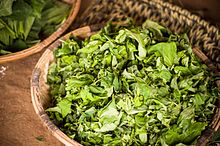Leaf vegetable
Food processing, such as drying and grinding into powder or pulping and pressing for juice, may involve these crop leaves in a diet.[2] Accordingly, users of vitamin K antagonist medications, such as warfarin, must take special care to limit the consumption of leaf vegetables.[5] In Greek cuisine, khorta (χόρτα, literally 'greens') are a typical side dish, eaten hot or cold and usually seasoned with olive oil and lemon.[6] At least 80 different kinds of greens are used, depending on the area and season, including black mustard, dandelion, wild sorrel, chicory, fennel, chard, kale, mallow, black nightshade, lamb's quarters, wild leeks, hoary mustard, charlock, smooth sow thistle and even the fresh leaves of the caper plant.Preboggion, a mixture of different wild boiled leaf vegetables, is used in Ligurian cuisine to stuff ravioli and pansoti.The word "botwinka" is the diminutive form of "botwina" which refers to leafy vegetables like chard and beet leaves.[10] Common fungal pathogens include: Alternaria brassicicola, A. alternata, A. arborescens, A. tenuissima, A. japonica, Colletotrichum higginsianum, Colletotrichum dematium f. spinaciae, Microdochium panattonianum, Stemphylium botryosum, Cladosporium variabile, Cercospora beticola, C. lactucae-sativae, C. brassicicola, C. acetosella, Botrytis cinerea, Golovinomyces cichoracearum, Podosphaera fusca, Erysiphe cruciferarum, E. polygoni, E. heraclei, Sclerotinia sclerotiorum, and S.



Spinachcolanderleavesvegetablepetiolesshootsplants with edible leavesherbaceous plantslettucefodderfaminealfalfaclovergrassesbarleyFood processingvitamin KPhylloquinonephotosynthesiscaloriesdietary fibervitamin Cvitamin Acarotenoidsfolatemanganesevitamin K antagonistwarfarinUnited Statesstir-friedstewedsteamedsoul foodSouthern U.S. cuisinetortillasandwichessaladsgreen smoothieamaranthCelosia argenteaWest African cuisineGreek cuisineolive oilblack mustarddandelionwild sorrelchicoryfennelblack nightshadelamb's quarterswild leekshoary mustardcharlocksmooth sow thistlepansotiravioliborageminestronefrittatacuisine of the Southern United Statestraditional African-American cuisineturnipcollardgarden cressmustardpokeweedpotlikkerItalian-AmericanUtica greensList of leaf vegetablesAgastache foeniculumNorth AmericaAllium fistulosumEast AsiaAlternanthera sissooBrazilBasella albaSoutheast AsiaNew GuineaBeta vulgarisSwiss chardBrassica oleraceacabbagegai lanJersey cabbagered cabbagesavoy cabbagecollard greensmustard greenskohlrabiBrassica rapanapa cabbagebok choybomdongchoy sumkomatsunarapinitatsoiradish greensCampanula versicolorBalkansChenopodium quinoaSouth AmericaCichorium endiviaescaroleCichorium intybusClaytonia perfoliataCnidoscolus aconitifoliusYucatán PeninsulaMexicoDaucus carota subsp. sativusEuropeSouthwestern AsiaEruca vesicariaMediterraneanFoeniculum vulgareGynura bicolorThailandMyanmarGynura procumbensHemerocallis fulvaLepidium meyeniiLactuca sativaceltucered leaf lettuceromaine lettuce
